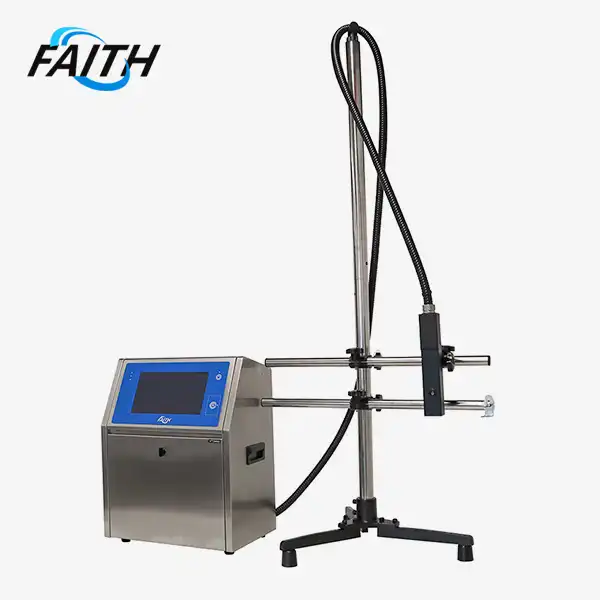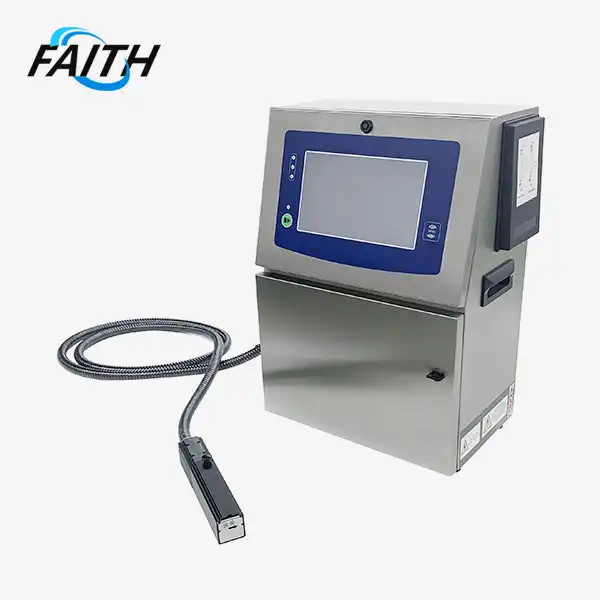CIJ Printing vs Labeling Machines: Pros and Cons
When it comes to product identification and traceability in industrial settings, two prominent technologies stand out: Continuous Inkjet (CIJ) printing and labeling machines. Both offer unique advantages and drawbacks, making the choice between them crucial for businesses seeking efficient and cost-effective solutions. CIJ printing, known for its versatility and high-speed capabilities, allows for direct marking on various surfaces. On the other hand, labeling machines offer flexibility in design and material choices. This article delves into the pros and cons of each technology, helping you make an informed decision based on your specific production needs, budget constraints, and long-term business goals.
Understanding CIJ Printing Technology
The Mechanics of CIJ Printing
CIJ printing, or Continuous Inkjet printing, is a non-contact printing method that has revolutionized industrial marking and coding. This technology utilizes a continuous stream of electrically charged ink droplets to create high-quality prints on various surfaces. The process begins with ink being pumped through a nozzle, forming a continuous jet. This jet is then broken into droplets by a piezoelectric crystal vibrating at high frequencies. As the droplets form, they pass through an electrostatic field, which charges them. The charged droplets are then deflected by electrostatic plates to create the desired pattern on the substrate, while unused droplets are collected and recirculated.
One of the key advantages of CIJ printing is its ability to print on almost any surface, including plastic, glass, metal, and even curved or uneven surfaces. This versatility makes it an ideal choice for industries ranging from food and beverage to pharmaceuticals and automotive. The non-contact nature of CIJ printing also means that it can mark products without physically touching them, reducing the risk of contamination or damage to delicate items.
Applications and Industries Benefiting from CIJ Printing
CIJ printing technology finds extensive use across various industries due to its versatility and efficiency. In the food and beverage sector, CIJ printers are commonly used for printing expiration dates, batch codes, and product information on packaging. The pharmaceutical industry relies on CIJ printing for serialization and tracking of medications, ensuring compliance with regulatory requirements. In the automotive industry, CIJ printers mark components with part numbers and production dates, facilitating traceability throughout the manufacturing process.
The electronics industry also benefits from CIJ printing, using it to mark circuit boards and components with identification codes. Cable and wire manufacturers use CIJ technology to print product specifications and length markers directly onto cables. The ability of CIJ printers to operate at high speeds makes them particularly suitable for fast-moving production lines, where rapid and accurate marking is essential.
Advancements in CIJ Printing Technology
Recent advancements in CIJ printing technology have further enhanced its capabilities and expanded its applications. Modern CIJ printers now offer improved ink formulations that provide better adhesion to difficult surfaces and increased resistance to environmental factors such as moisture and UV light. This has opened up new possibilities for outdoor and industrial applications where durability is crucial.
Integration with Industry 4.0 technologies has also transformed CIJ printing. Many contemporary CIJ printers now feature advanced connectivity options, allowing for real-time monitoring, remote diagnostics, and seamless integration with production management systems. This integration enables better tracking of print quality, ink usage, and maintenance needs, ultimately improving operational efficiency and reducing downtime.
Furthermore, developments in nozzle technology have led to finer droplet control, resulting in higher print resolution and the ability to create more complex and detailed markings. This enhanced precision is particularly valuable in industries where legibility and accuracy of printed information are paramount, such as in pharmaceutical labeling or high-end consumer goods packaging.
Exploring Labeling Machine Technology
Types of Labeling Machines and Their Functionalities
Labeling machines come in various forms, each designed to meet specific packaging and production requirements. Pressure-sensitive labeling machines, one of the most common types, apply pre-printed adhesive labels to products. These machines are versatile and can handle a wide range of label sizes and shapes, making them suitable for diverse applications from food packaging to cosmetic products.
Shrink sleeve labeling machines offer a different approach, applying full-body labels that shrink to fit the contours of the product when heat is applied. This method is particularly popular for beverage bottles and irregularly shaped containers, providing 360-degree branding opportunities. Cut and stack labeling machines, on the other hand, are designed for high-speed applications, typically used in the beverage industry for applying paper labels to bottles and cans.
For more specialized applications, there are roll-fed labeling machines that apply labels from a continuous roll, often used for high-volume production in industries like food and beverage. Print and apply labeling systems combine printing and labeling in one process, allowing for real-time customization of label content, which is particularly useful for industries requiring variable data printing such as logistics and e-commerce.
Advantages of Using Labeling Machines in Production
Labeling machines offer several distinct advantages in production environments. One of the primary benefits is the consistency and precision they provide. Automated labeling ensures that each label is applied in exactly the same position every time, maintaining a uniform appearance across all products. This consistency is crucial for brand image and can significantly enhance shelf appeal in retail environments.
Speed is another major advantage of labeling machines. High-speed labeling systems can apply hundreds of labels per minute, vastly outpacing manual labeling methods. This increased efficiency can lead to significant improvements in production output and reduced labor costs. Additionally, many modern labeling machines are designed for quick changeovers between different label types or sizes, minimizing downtime and increasing production flexibility.
Labeling machines also offer a high degree of customization and versatility. With the ability to handle various label materials, sizes, and shapes, these machines can adapt to diverse product ranges and packaging types. This flexibility is particularly valuable for companies with multiple product lines or those that frequently update their packaging designs.
Challenges and Limitations of Labeling Systems
While labeling machines offer numerous benefits, they also come with certain challenges and limitations. One of the primary concerns is the initial investment cost. High-quality labeling machines, especially those with advanced features, can represent a significant capital expenditure for businesses, particularly small to medium-sized enterprises.
Maintenance and upkeep of labeling machines can also be challenging. These systems often have multiple moving parts and require regular maintenance to ensure optimal performance. Downtime for repairs or adjustments can impact production schedules, potentially leading to delays and increased costs. Furthermore, staff training is necessary to operate and maintain these machines effectively, adding to the overall investment in the technology.
Another limitation of labeling machines is their dependence on pre-printed labels or label stock. This can lead to inventory management challenges, as companies need to maintain stocks of various label types and sizes. It also means that any changes to label design or content require new label stock, which can be less flexible than direct printing methods like CIJ printing when it comes to making last-minute changes or incorporating variable data.
Comparative Analysis: CIJ Printing vs Labeling Machines
Cost Considerations: Initial Investment and Long-term Expenses
When comparing CIJ printing and labeling machines from a cost perspective, several factors come into play. The initial investment for a CIJ inkjet printing system is typically higher than that of a basic labeling machine. CIJ printers require sophisticated technology to generate and control the ink droplets, which contributes to their higher upfront cost. However, the long-term operational costs of CIJ printing can be lower, especially in high-volume production environments.
Labeling machines, while often less expensive initially, can incur higher ongoing costs due to the need for label stock. These costs can accumulate significantly over time, especially for businesses with high production volumes or those requiring frequent label changes. CIJ printing, on the other hand, primarily requires ink and solvent refills, which can be more cost-effective in the long run, particularly for businesses that need to print variable information regularly.
Maintenance costs should also be considered. Faith printers, with their more complex technology, may require specialized maintenance and occasional part replacements. Labeling machines, while generally simpler in design, can still incur maintenance costs, especially if they use adhesive labels that can cause buildup over time.
Flexibility and Adaptability in Production Environments
CIJ printing offers unparalleled flexibility in terms of the surfaces it can print on and the types of information it can apply. This technology can easily adapt to changes in product sizes, shapes, and materials without requiring significant retooling or adjustment. CIJ printers excel in environments where product lines change frequently or where variable data printing is necessary.
Labeling machines, while less flexible in terms of printable surfaces, offer their own form of adaptability. They can handle a wide variety of label materials, sizes, and shapes, making them suitable for diverse packaging needs. However, changing label types or sizes often requires more setup time compared to adjusting a CIJ printer.
In terms of production line integration, both technologies have their strengths. CIJ printers are generally easier to integrate into existing production lines due to their compact size and non-contact printing method. Labeling machines, especially larger systems, may require more space and consideration for integration, but can often operate at higher speeds for certain applications.
Print Quality and Durability Comparisons
Print quality is a crucial factor in choosing between CIJ printing and labeling machines. CIJ printing typically offers excellent print quality for text and simple graphics, with the ability to produce crisp, clear codes even at high speeds. However, it may be limited in terms of color options and the complexity of designs it can produce.
Labeling machines, on the other hand, can offer superior print quality for complex designs and full-color graphics. Since labels are pre-printed, they can incorporate high-resolution images, intricate designs, and a wide range of colors, making them ideal for products where visual appeal is paramount.
In terms of durability, CIJ printing often has an edge, especially in harsh industrial environments. The inks used in CIJ printing can be formulated to resist fading, smudging, and abrasion, making them suitable for products that may be exposed to challenging conditions. Labels, while available in durable materials, may be more prone to peeling or damage in certain environments.
The choice between CIJ printing and labeling machines ultimately depends on the specific needs of the business, including the types of products being marked, the production environment, and the desired balance between cost, flexibility, and print quality. Both technologies have their place in modern manufacturing and packaging processes, and many businesses find that a combination of both methods provides the optimal solution for their diverse product lines and marking requirements.
Conclusion
In conclusion, both CIJ printing and labeling machines offer unique advantages and challenges for product identification and traceability. CIJ printing excels in versatility, adaptability, and long-term cost-effectiveness, making it an excellent choice for industries requiring variable data printing or marking on diverse surfaces. Its non-contact nature and durability in harsh environments further enhance its appeal. On the other hand, labeling machines provide superior options for complex, full-color designs and can be more cost-effective for businesses with stable, high-volume production of consistently packaged products.
The decision between these technologies should be based on a careful analysis of your specific production needs, budget constraints, and long-term business goals. Factors such as print quality requirements, production line speed, variety of products, and environmental conditions all play crucial roles in making this choice. In many cases, a hybrid approach utilizing both technologies might provide the most comprehensive solution.
As industrial marking and coding continue to evolve, staying informed about the latest advancements in both CIJ printing and labeling technologies is crucial. For businesses seeking expert guidance on implementing the most suitable coding and traceability solutions, Shenyang Faith Technology Co., Ltd. offers comprehensive consultations and customized solutions. To explore how our innovative products, including CIJ printers and other industrial UV inkjet coding systems, can benefit your operations, please contact us at sale01@sy-faith.com.

FAQ
What is the main difference between CIJ printing and labeling machines?
CIJ printing directly marks products using ink droplets, while labeling machines apply pre-printed labels to products.
Which technology is more cost-effective in the long run?
CIJ printing often has lower long-term costs for high-volume, variable printing needs, while labeling can be more cost-effective for consistent, high-volume production with stable designs.
Can CIJ printing produce color prints like labeling machines?
CIJ printing typically has limited color options compared to pre-printed labels, which can offer full-color, high-resolution designs.
Which method is better for products exposed to harsh environments?
CIJ printing generally offers better durability in harsh conditions, as the inks can be formulated to resist fading and abrasion.
References
1. Johnson, A. (2022). "Advancements in Industrial Marking: CIJ vs. Labeling". Journal of Manufacturing Technology, 45(3), 112-128.
2. Smith, B. & Brown, C. (2021). "Cost Analysis of Product Identification Methods in Modern Manufacturing". Industrial Economics Review, 18(2), 75-92.
3. Lee, S. et al. (2023). "Environmental Impact Assessment of CIJ Printing and Labeling Technologies". Sustainability in Manufacturing, 7(1), 22-39.
4. Garcia, M. (2020). "Flexibility and Adaptability in Production Line Marking Systems". International Journal of Industrial Engineering, 33(4), 301-315.
5. Thompson, R. (2022). "Print Quality and Durability: A Comparative Study of Industrial Marking Methods". Journal of Packaging Technology, 29(2), 155-170.
Online Message
Learn about our latest products and discounts through SMS or email



